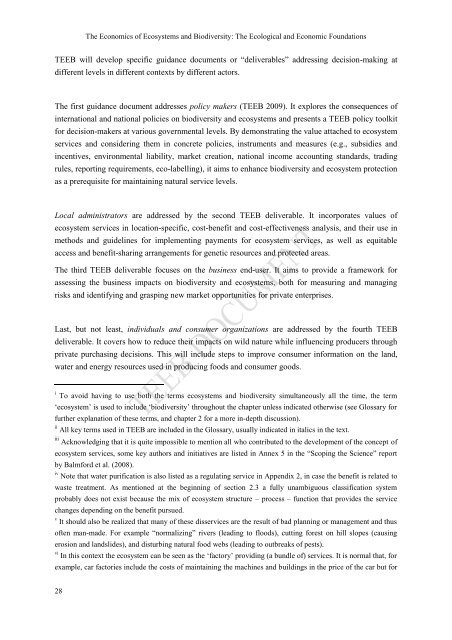Chapter 1 Framework of integration of ecology and economy ... - TEEB
Chapter 1 Framework of integration of ecology and economy ... - TEEB
Chapter 1 Framework of integration of ecology and economy ... - TEEB
You also want an ePaper? Increase the reach of your titles
YUMPU automatically turns print PDFs into web optimized ePapers that Google loves.
The Economics <strong>of</strong> Ecosystems <strong>and</strong> Biodiversity: The Ecological <strong>and</strong> Economic Foundations<strong>TEEB</strong> will develop specific guidance documents or “deliverables” addressing decision-making atdifferent levels in different contexts by different actors.The first guidance document addresses policy makers (<strong>TEEB</strong> 2009). It explores the consequences <strong>of</strong>international <strong>and</strong> national policies on biodiversity <strong>and</strong> ecosystems <strong>and</strong> presents a <strong>TEEB</strong> policy toolkitfor decision-makers at various governmental levels. By demonstrating the value attached to ecosystemservices <strong>and</strong> considering them in concrete policies, instruments <strong>and</strong> measures (e.g., subsidies <strong>and</strong>incentives, environmental liability, market creation, national income accounting st<strong>and</strong>ards, tradingrules, reporting requirements, eco-labelling), it aims to enhance biodiversity <strong>and</strong> ecosystem protectionas a prerequisite for maintaining natural service levels.Local administrators are addressed by the second <strong>TEEB</strong> deliverable. It incorporates values <strong>of</strong>ecosystem services in location-specific, cost-benefit <strong>and</strong> cost-effectiveness analysis, <strong>and</strong> their use inmethods <strong>and</strong> guidelines for implementing payments for ecosystem services, as well as equitableaccess <strong>and</strong> benefit-sharing arrangements for genetic resources <strong>and</strong> protected areas.The third <strong>TEEB</strong> deliverable focuses on the business end-user. It aims to provide a framework forassessing the business impacts on biodiversity <strong>and</strong> ecosystems, both for measuring <strong>and</strong> managingrisks <strong>and</strong> identifying <strong>and</strong> grasping new market opportunities for private enterprises.Last, but not least, individuals <strong>and</strong> consumer organizations are addressed by the fourth <strong>TEEB</strong>deliverable. It covers how to reduce their impacts on wild nature while influencing producers throughprivate purchasing decisions. This will include steps to improve consumer information on the l<strong>and</strong>,water <strong>and</strong> energy resources used in producing foods <strong>and</strong> consumer goods.iTo avoid having to use both the terms ecosystems <strong>and</strong> biodiversity simultaneously all the time, the term„ecosystem‟ is used to include „biodiversity‟ throughout the chapter unless indicated otherwise (see Glossary forfurther explanation <strong>of</strong> these terms, <strong>and</strong> chapter 2 for a more in-depth discussion).ii All key terms used in <strong>TEEB</strong> are included in the Glossary, usually indicated in italics in the text.iii Acknowledging that it is quite impossible to mention all who contributed to the development <strong>of</strong> the concept <strong>of</strong>ecosystem services, some key authors <strong>and</strong> initiatives are listed in Annex 5 in the “Scoping the Science” reportby Balmford et al. (2008).iv Note that water purification is also listed as a regulating service in Appendix 2, in case the benefit is related towaste treatment. As mentioned at the beginning <strong>of</strong> section 2.3 a fully unambiguous classification systemprobably does not exist because the mix <strong>of</strong> ecosystem structure – process – function that provides the servicechanges depending on the benefit pursued.v It should also be realized that many <strong>of</strong> these disservices are the result <strong>of</strong> bad planning or management <strong>and</strong> thus<strong>of</strong>ten man-made. For example “normalizing” rivers (leading to floods), cutting forest on hill slopes (causingerosion <strong>and</strong> l<strong>and</strong>slides), <strong>and</strong> disturbing natural food webs (leading to outbreaks <strong>of</strong> pests).vi In this context the ecosystem can be seen as the „factory‟ providing (a bundle <strong>of</strong>) services. It is normal that, forexample, car factories include the costs <strong>of</strong> maintaining the machines <strong>and</strong> buildings in the price <strong>of</strong> the car but for28
















